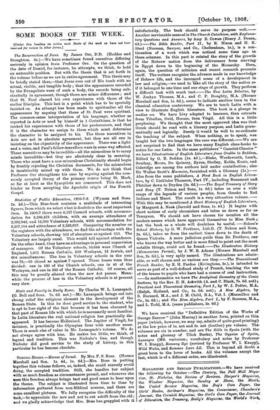ScHooL-Booxs.—Heroes of Israel. By Mrs. F. S. Boas. (Horace Marshall
and Son. ls. 4d., ls. 6d.)—Mrs. Boas in putting together this volume follows, as, indeed, she could scarcely avoid doing, the accepted tradition. Still, she handles her subject with as much freedom as circumstances permit, and whenever she uses this freedom always brings tact and good sense to bear upon the theme. The subject is illustrated from time to time by information gathered from non-Biblical sources, and there are some excellent pictures. We fully recognise the difficulty of the task,—to appreciate the new and not to cut adrift from the old ; and we gladly acknowledge that Mrs. Boas has grappled with it
satisfactorily. The book should serve its purpose well.— Another serviceable manual is The Church Catechism, with Explana- tory Questions and Answers, by Amy B. Cowan (Henry J. Drape,: 6d.)—The Bible Reader, Part II., by E. Nixon and H. R. Steel (Norman, Sawyer, and Co., Cheltenham, ls.), is a con- tinuation of a work which was noticed some time ago in these columns. In this part is related the story of the growth• of the Hebrew nation from the deliverance from starving in Egypt down to the beginning of the Monarchy. Here,. again, the question of criticism and recent research presents itself. The writers recognise the advance made in our knowledge - of Hebrew life, and the increased sense of a development in law and religion,—we used to take all the story of the nation as if it belonged to one time and one stage of growth. They perform a difficult task with much tact.—The New Latin Delectus, by W. Jenkyn Thomas, M.A., and C. P. Doughty, M.A. (Horace Marshall and Son, Is. 6d.), seems to indicate another turn in the classical education controversy. We are to teach Latin with a. view to illustrate English literature. The book is a plunge in medias res. We have Livy adapted to learners, then extracts- from Tibullus, Ovid, Horace, then Virgil. All this is a little- perplexing. We thought that the most approved idea was that- Greek should be read with a literary purpose, and Latin gram- matically and logically. Surely it would be well to co-ordinate- the teaching of the subject. When nothing, so to speak, was- taught but the two languages the case was different.—We are- not surprised to find that we have many English class-books to-- notice for one Latin. In tho same publishers' " Camelot Classics " we have Illustrations of English Literature from Crabbe to Beddoes,_ Edited by G. B. Seddon (1s. 4d.),—Blake, Wordsworth, Lamb._ Southey, Moore, De Quincey, Byron, Shelley, Keble, Keats, and Coleridge are among the authors laid under contribution ; also- Sir Walter Scott's Marmion, furnished with a Glossary (ls.)- Also from the same publishers, A First Book in English Litera- ture, by C. Linklater Thomson, Part IV., including Beaumont an&
Fletcher down to Dryden (2s. 6d.)—The Royal Treasury of Story- and Song (T. Nelson and Sons, Is. 6d.) takes us over a wide- range of the legends of various peoples, from Greeks to Red.
Indians and Maori. The result is a very attractive volume.— With this may be mentioned A Short History of English Literature,.
by Margaret A. Nask (Jarrold and Sons, is. 4d.) It begins with short notices of early chroniclers and takes us down as far as' Tennyson. We should not have chosen for mention all the.
modern names which have approved themselves to Miss Nash ;:
but the book as a whole will doubtless be useful. —Nelson's- School History, by G. W. Prothero, Litt.D. (T. Nelson and Sons,
2s. 6d.), takes us from the earliest times down to the death of Queen Victoria. A more judicious guide than Dr. Prothero, one- who knows the way better and is more fitted to point out the most.
notable things, could not be found.—The Illustrative History.
(Hanoverian Period), by J. W. B. Adams (Horace Marshall and. Son, 2s. 6d.), is very aptly named. The illustrations are admir-
able, so well chosen and so various are they.—The Transitional' French Reader, by R. H. Pardee (Rivingtons, 3s.), is intended to- serve as part of a well-defined study of French, teaching the use of the tenses to pupils who have had a course of oral instruction.
—In mathematics we have The Analytical Geometry of the Conic. Sections, by the Rev. E. H. Askwith (A. and C. Black, 7s. 6d. net); Practical and Theoretical Geometry, Part I., by W. J. Potter, M.A. (Ralph, Holland, and Co., ls. 6d. net) ; A New Algebra, by S. Barnard, M.A., and J. M. Child, BA., Vol. I. (Macmillan and Co., 2s. 6d.) ; and The Eton Algebra, Part I., by P. Scoones, M.A.,. and L. Todd, M.A. (same publishers, 2s. 6d.)














































 Previous page
Previous page